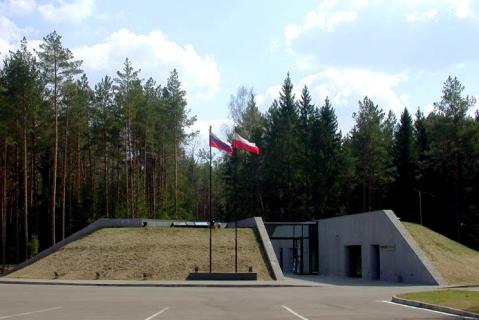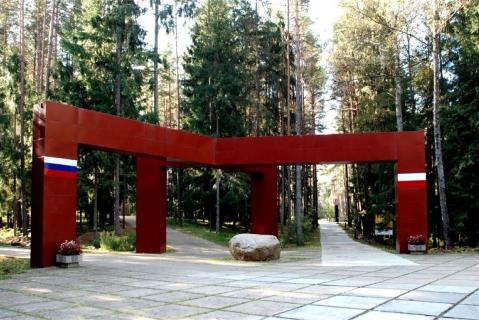The memorial complex is located 20 kilometres from the centre of Smolensk in a wooded area where citizens of two countries, the USSR and Poland were executed.
Burials of Soviet citizens shot in Smolensk were made there, it is assumed, from the late 1920s onwards. In spring 1940 more than 4,000 Polish prisoners of war were shot and buried in the woods of Katyn. They were captured in September 1939 when the Soviet Union occupied the eastern territories of Poland; and then confined to a POW camp in Kozyolsk. The remains of the Polish officers were first exhumed in 1943 when the forces of the Third Reich occupied that part of the USSR. After the end of the Second World War the Katyn woods were closed to outside visitors.
In 1988 the USSR Council of Ministers adopted a resolution, “On the building in Katyn, Smolensk Region, of a memorial complex on the burial place of Polish officers and also a monument to Soviet POWs who died during the Great Patriotic War”. In 1990 Russia admitted that the Polish officers had been shot by the NKVD. Exhumation of their remains took place in 1990 and again in 1994-1995. A list was compiled of 4,413 Polish POWs who were buried in the Katyn woods.
The burials of Soviet citizens were selectively studied in 1995 and 1998. As of 2015 no full investigation of the entire territory had been conducted. Authoritative evidence of the number of Soviet citizens interred in the woods has not been found, but documents refer to “more than 6,000 victims of Stalinist repression”. (See “Books of Remembrance”, Smolensk cemetery.)
*
Work on the memorial began after an agreement between the Russian and Polish governments was signed in Krakow on 22 February 1994 about burials and memorial sites of the victims of war and repression in Russia. The RF Ministry of Culture and the Polish Council were joint organisers and investors in the construction. Work on the memorial began in 1999 and it was opened on 28 July 2000. It combines a Polish military cemetery and the burials of Soviet victims of political repression. A complex of ritual and architectural structures has been created on the site. Further work on the Russian part of the memorial was halted and there was discussion of the development of still unstudied mass burials of Soviet citizens in the Katyn woods. The complex also includes an exhibition centre (opened in 2008) and a reconstruction of “the Gulag on Wheels” (opened in 2007).
See also the Mednoe memorial complex [69-04] in the Tver Region.
*
As of December 2021 the Katyn Memorial Complex was downgraded on the RF Ministry of Culture’s Unified Register of Sites of Cultural Heritage from a monument of federal importance to one of regional significance; as in the years before 1988 it was again described as the place where the “Hitlerites” murdered thousands of Polish army officers.
The official website of the Katyn Memorial is more ambivalent. It states that the Nazis tried to use Katyn for propaganda purposes, but also quotes the TASS statement of regret (13 April 1990) describing the mass executions at Katyn as a “crime of Stalinism” and refers to the later release of the 5 March 1940 Politburo decision whereby inmates of POW camps and prisons in occupied eastern Poland were to be shot.
| Date | Nature of ceremonies | Organiser or responsible person | Participants | Frequency |
|---|---|---|---|---|
|
10 April
|
Anniversary of 1940 Katyn Tragedy
|
Katyn Memorial Complex
|
Public and Regional Administration, Polish governmental delegation, delegations from other countries
|
Annual event
|
|
28 July
|
Day of Truth and Remembrance; anniversary of opening of the Memorial Complex
|
Katyn Memorial Complex
|
Officials from Smolensk urban district, Polish diplomatic mission, State Museum of Russian contemporary history, NGOs from Smolensk, Orthodox and Catholic clergy
|
Annual Event
|
|
30 October
|
Remembrance Day for the Victims of Political Repression
|
Katyn Memorial Complex
|
Regional Administration officials and NGOIs in the Smolensk Region, ROC clergy, inhabitants and guests from the city of Smolensk and the Smolensk Region
|
Annual Event
|
|
1 November
|
All Souls Day
|
Katyn Memorial Complex
|
The Polish diplomatic mission in Russia, NGOs from Smolensk
|
Annual Event
|
|
8 December
|
Feast of Holy Martyr Archbishop Seraphim (Ostroumov) of Smolensk
|
Katyn Memorial Complex
|
Clergy of the ROC's Smolensk and Vyazma diocese, students from Orthodox seminaries, military cadets, pilgrims and a delegation from the Polish Republic
|
Annual Event
|
| State of burials | Area | Boundaries |
|---|---|---|
|
burials of Polish POWs are denoted with memorial signs; burials of Soviet citizens are indicated in part but most are not shown or protected
|
total area 18.5 hectares, of which 10.5 have been developed and are in use
|
There is a fence around the grounds of the memorial complex
|
[ original texts and hyperlinks ]
Shot at Katyn, an Index of the repressed, Vol. 1 Karta centre: Warsaw, 1995 {in Polish: Rozstrzelani w Katyniu. Indeks represjonowanych / Ośrodek KARTA. - T. 1. - Warszawa, 1995}
“Electronic images of the original archival documents concerning the Katyn issue from ‘collection No. 1’,” The Archives of Russia portal
Katyn, March 1940-September 2000. Shooting. The fate of the living. The echo of Katyn. Documents, N.S. Lebedeva (compiler), Moscow, 2001 (688 pp)
G.A. Andreyenkova, “Commemorating Soviet citizens who were victims of repression on the territory of the Katyn Memorial”, official website of the Katyn memorial
Truth and Remembrance, a guide to the exhibition, Katyn, 2011
See “History” Official website of the Katyn Memorial Complex [retrieved, 9 January 2025] {in Russian and English}
*
Airat Bagautdinov, “The Katyn Memorial Complex”, The Dmitriev Affair website (March 2022) {in English}


